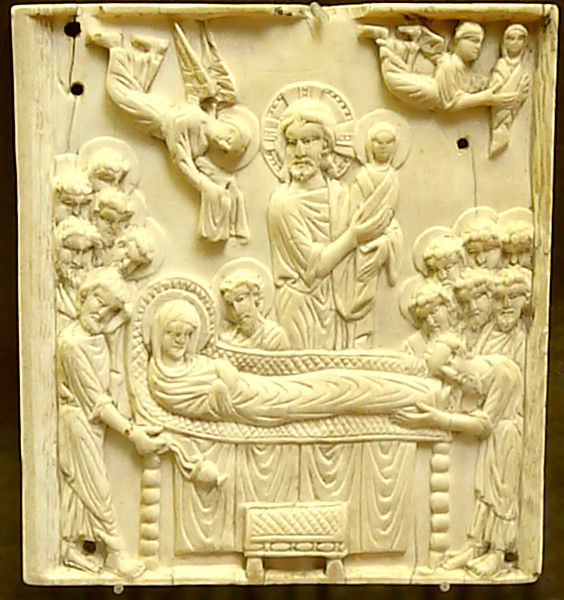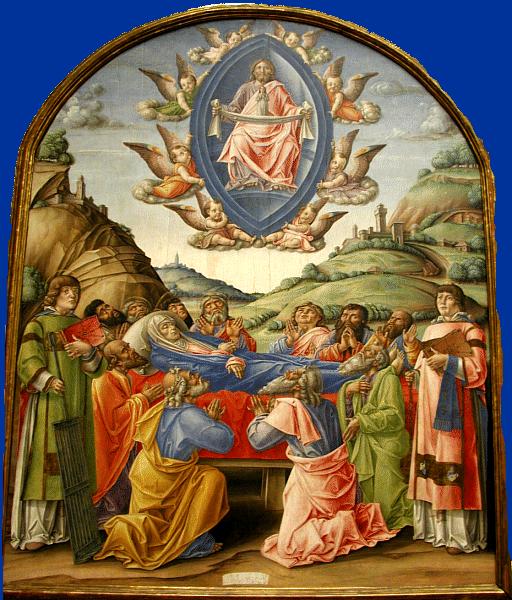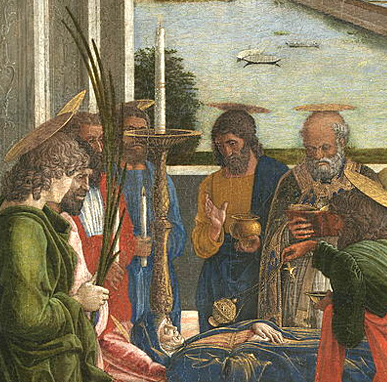The writers never refer to Mary as dying; rather, she "fell asleep." The Latinate phrase "Dormition of the Virgin" refers to images of this falling asleep, which art historians and museum curators sometimes tendentiously label "The Death of the Virgin."
Images of the Dormition go back to at least the 9th century. In the first picture at right, we see their basic pattern: Mary's body reclines on a bier attended by the Apostles while her soul is taken in hand by Christ. The soul is signified by a child-like figure that is either clothed or swaddled. Often one or more of the Apostles will be pictured with objects used in funeral rites, such as a book, a censer, or candles.
In early versions such as the one at right, Christ hands the soul up to an angel, who in this case is represented on the left as approaching with covered hands and on the right as ascending with Mary's soul. The assignment of this duty to an angel follows John Damascene (Toal, III, 431-32) and Gregory of Tours' Glory of the Martyrs (22), who identifies the angel as Michael. Some images follow this example, but most are like the second picture at right, where Christ himself carries his mother's soul aloft.
THE APOSTLES AT MARY'S BEDSIDE
In many images Christ has already taken the soul and the Apostles gather around the recumbent Virgin to celebrate the Office of the Dead – with candles, books, an aspergillum, a hand-held sprinkler, often of precious metal, for sprinkling holy water onto a person or group being blessed a censer, A closed, perforated vessel for burning incense with a chain at the top so the celebrant can waft the smoke back and forth as it rises. and the like. In the first half of the 8th century St. Germanus of Canstantinople wrote that the privilege of offering "the accustomed prayer" over the body had been accorded to St. Peter, so in these images he is usually the one reading from the breviary.2 In the third picture at right he wears liturgical vestments, but usually all the apostles are pictured conventionally: barefoot, with flowing mantles over long tunics.
In other images St. John lifts the Mary's body up to place it on the bier while the other Apostles look on (example).
The number of Apostles in these images varies. Often there will be eleven (example). This is because The Passing of Mary and one version recounted by the Golden Legend say St. Thomas did not arrive until later. Elsewhere one may count twelve apostles, but one of them may be the supernumerary Paul (example). A smaller piece may include just a few (example).
Besides the Apostles, some images will show a large number of people in attendance (example), following the tradition expressed in St. Andrew of Crete and John of Damascus. Pseudo-Joseph of Arimathea adds three of Mary's maiden companions, but it is rare for any women at all to be pictured.3
THE PALM BRANCH
In John of Thessalonica's Dormition account, Mary is told of her imminent transit to Heaven by "the great angel," who gives her a palm branch that "he who planted Paradise" had entrusted to him. He tells her to give it to the apostles to carry in the funeral procession, explaining that "by it many shall be healed." In the third picture at right St. John holds the palm branch. In this one Peter holds it. In Ghirlandaio's fresco one of the Apostles holds a young palm tree in his hand. I have seen a few other examples, but usually the artists ignore it.4
THE ASSAULT OF THE JEWS
In most accounts a Jewish crowd assaults the bier while the Apostles are taking it to the cemetery in Gethsemane. One of them, identified in some sources as the Chief Priest, lays his hands on the bier in an attempt to cast it to the ground. His hands then wither or fall off, depending on the source (example). Astonished by this miracle the man repents and converts to Christianity, whereupon he gets his hands back.5 Some Orthodox images have the hands cut off by an angel (See this example and others cited by Professor Boguslawsky ["The Assumption"], who identifies the angel as St. Michael.)
COMBINED IMAGES
Narrative images of the Dormition are sometimes part of compositions that integrate it with the Assumption (example) or the Coronation of Mary (example) or both (example).
Prepared 2016-01-04 by Richard Stracke, Emeritus Professor of English, Augusta University. Revised 2017-04-11, 2017-11-28.
NEXT:
PART SIX, THE ASSUMPTION
ALSO SEE PARTS:
1
2
3
4
6
7
8
HOME PAGE
NOTES
1 See the 4th-century Book of John Concerning the Falling Asleep of Mary. In the 5th century Juvenal of Jerusalem wrote a detailed account of Mary's "glorious falling asleep," which he said "we have received from ancient and most reliable tradition." In the 6th, Gregory of Tours wrote of how Christ "took the holy body in a cloud and ordered it to be brought to Paradise, where, after regaining her soul, Mary now rejoices with his elect" (Glory of the Martyrs, 22). Juvenal's account was reproduced in 749 in John Damascene's "Second Oration on the Dormition" (Migne, Patrologia Graeca, XCVI, col. 722-52; Toal, IV, 437). It had been expounded with greater detail in 730 in Germanus of Constantinople's "Third Discourse on the Dormition" (Patrologia Graeca, XCVIII, col. 359-71; Toal, IV, 418-24). All five of these writers emphasize that Mary's body never suffered corruption and was received into Heaven only a short time after her "falling asleep." As John Damascene put it, "How could corruption dare touch the body that contained Life?" (¶3, Toal IV, 427). According to Toal (IV, 443) the Eastern church taught the doctrine of the Dormition / Assumption from the 5th century onward. It was celebrated on August 15 starting in the 6th century in the East and the 7th century in the West. The version in the Golden Legend in the 13th century is based on the Book of John and further popularized the account. It also cited St. Jerome's defense of the belief in Mary's bodily assumption into Heaven. This belief was not actually defined as Roman Catholic dogma until Pius XII's pronouncement in 1950 "that the Immaculate Mother of God, the ever Virgin Mary, having completed the course of her earthly life, was assumed body and soul into heavenly glory." The pronouncement, Munificentissimus Deus, contains a survey of early, medieval, and early modern writings on the subject (¶¶16-37). For a survey similar to the one on this page, see Salvador Gonzalez.
2 Third Discourse on the Dormition, in Toal, IV, 422).
3 For Andrew of Crete's remarks on the attendees, see Daley, 129-31. For John of Damascus (Homily II on the Dormition), Daley, 210-211. The latter is also available online from Fordham University's Internet Medieval Sourcebook. For pseudo-Joseph of Arimathea a Spanish translation is in Santos Otero's Los Evangelios Apócrifos.
4 John of Thessalonica's account of the palm branch is in Daley, 49-50. The angel is identified as Gabriel in the "Book of St. John the Evangelist." See Santos Otero, 307-322.
5 Ryan, II, 81. Toal, IV, 422, 433. In an extended narration of the episode by John of Thessalonika the Chief Priest loses his hands, repents, and is cured. Of the other Jews who attacked the bier all are struck blind, but only some of them repent and regain their sight. (Daley, 64-67).

Constantinople, 10th or 11th century (See description page)

Vivarini's Death of the Virgin has Christ carry his mother aloft on her shroud, in a mandorla that is itself carried by a host of angels. In the foreground the artist adds Saints Lawrence, Peter, Paul, and a deacon saint (Vincent?). (See the description page.)

In this detail from Mantegna's Death of the Virgin St. Peter in vestments reads from the Office of the Dead while one Apostle censes the body and another holds the oil jar. As specified in the Golden Legend, it is given to St. John to hold the palm branch described as "symbol of her victory against death" by St. Germanus (Toal, 420). (See the description page for the full painting and commentary.)
MORE IMAGES
- Undated, probably early: In this Dormition mosaic in Ravenna an angel with covered hands prepares to receive Mary's soul from Christ to take it to Heaven.
- 1180: In Maastricht, the Netherlands, the south tympanum has the Dormition in the lower register, the Coronation of Mary in the upper register, and the Holy Kinship in the archivolt.
- 14th century: German manuscript illumination.
- 1390s: The Dormition is the central image on the predella of Cenni di Francesco's Coronation of the Virgin.
- 15th century (est.) a panel in the Mariapfarr (Austria) Altarpiece.
- Circa 1410: Taddeo di Bartolo's unusual combination of Dormition and Assumption imagery.
- 1447: This unusual Dormition borrows iconography from the Annunciation and Coronation.
- Late 15th century: Relief in wood.
- 1485-90: The Dormition appears at the summit of Ghirlandaio's monumental Life of the Virgin.
- Circa 1500: a high relief in Passau, Germany.
- 16th century: This version by Simone de Wobrek is a rare example of a Dormition without Christ. Instead, the angels carry Mary up to the welcoming Father.
- 16th century: Cola dell'Amitrice's painting of the Dormition and Assumption.
- 16th century: The Croatian artist Anthony of Padua's fresco.
- Undated, possibly 18th or late 17th century: An Assumption image in Venice's San Zulián church includes details related to the Mass for the Dead that are common in Dormitions but not in Assumptions.
DATES
- In the West August 15 is celebrated as the Feast of the Assumption. In the East the same day is called the Feast of the Dormition.
RELEVANT MEDIEVAL AND EARLY CHRISTIAN TEXTS
- Golden Legend #119 (The Assumption): html or pdf.
- Daley, On the Dormition of Mary: Early Patristic Commentaries presents a number of texts on this subject.
- The Book of John Concerning the Falling Asleep of Mary:, besides being in Daley (203-223) is online at CCEL.
- Gregory of Tours, The Glory of the Martyrs.
- John Damascene, "Second Oration on the Dormition": in Toal, IV, 425-38 and online in Latin and Greek at Migne, Patrologia Graeca.
- Germanus of Constantinople, "Third Discourse on the Dormition" in Toal, IV, 418-24, Daley, 153-66, and online in Latin and Greek at Migne, Patrologia Graeca.
- Also see Pius XII, Munificentissimus Deus: online at the web site of the Holy See.
ALSO SEE